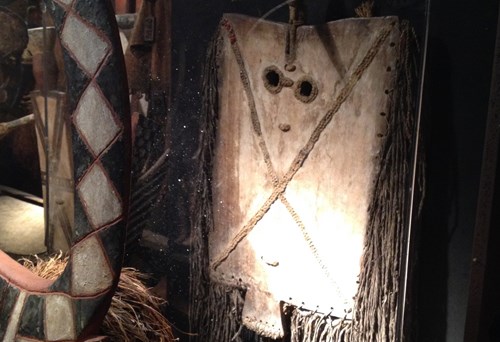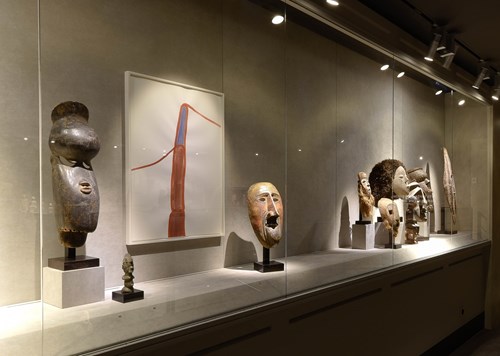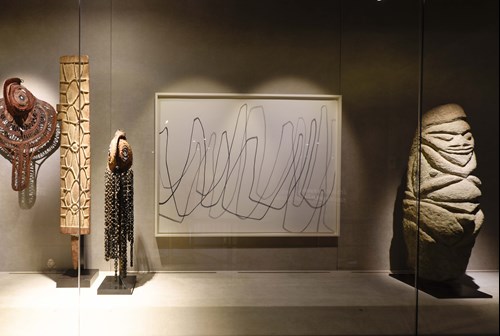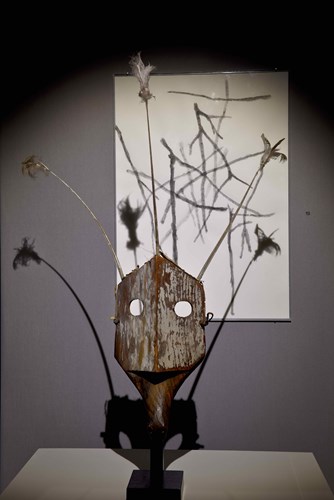
When the Barbier-Mueller Museum offered Swiss artist Silvia Bächli the opportunity to curate its next exhibition, she conceived of the experience as a creative occasion for dialogue between the museum’s artifacts and her drawings.
When the Barbier-Mueller Museum offered Swiss artist Silvia Bächli the opportunity to curate its next exhibition, she conceived of the experience as a creative occasion for dialogue between the museum’s artifacts and her drawings. The collaborative result is Faraway Arts So Close in Silvia Bächli’s Eyes, in which Bächli brings 16 of her gouaches on paper in correspondence with 60 objects chosen from the Barbier-Mueller’s reserves. Bächli is interested in “the confrontation” between the clear, simple forms of the museum objects and the elusive, complex character of her works. With an artistic style uniquely her own, Bächli’s paintings emphasize the gesture and movement of line, in sharp contrast to the three-dimensional physicality of the museum’s collection items.
Bächli’s art presents a reality of fragments and things not fully articulated. Her works tell stories without finite beginnings or endings, through stills and moments in time. “Drawing is experimenting, groping one’s way and playing,” explains Bächli. “My drawings are closer to music than to narrative stories.” Somewhere between abstraction and figuration, Bächli’s imagery is grounded in the tangible then distilled into undertones and essence. Open spaces of canvas are as purposeful as the lines themselves, sweeping motion and intonation. The artist’s hand is ever present - in the starts and starts of line, the wax and wane of density, the intensity and its leveling or absence, and the domain of what that concentration or lightness conveys.
ArtDependence Magazine: In your current exhibition Faraway Arts So Close in Silvia Bächli’s Eyes, you display selections of your gouaches on paper alongside objects chosen from the museum’s reserves. What was the process for determining your works and the collection’s items for the exhibit?
Silvia Bächli: To choose works from the Barbier-Mueller collection and exhibit them together with my own drawings is a dream. In the museum storage room, all objects of the collection are on shelves, standing close together: sculptures, masks, shields, seats, receptacles of every sort, and many other things as well. Equipped with my cellphone, I instantly photographed these scenes, capturing constellations of objects. Entire populations whom I know nothing about, they are there, alien to me, unknown. Voiceless, they speak to me. They touch me, and yet their magic is not my own. Created with intensity and urgency, they express their desires and their fears. At home, I have printed the photos of the objects - and also the photos of the drawings. (All drawings are from 1995 – 2017.) Like in a card game I put the different pieces next to each other. What changes if I combine them? Are they talking to each other?

Exhibition Musée Barbier-Mueller, Geneva, 2018. Foto Luis Lourenco

Toussian, Burkina Faso. Musée Barbier-Mueller, Geneva. Foto Silvia Bächli

Silvia Bächli, Rhomb, 2015, Gouache, 102x72cm. Privat collection, Geneva.

Bena Kanyoka, Lega, Republique démocratique du Congo. Musée Barbier-Mueller, Geneva. Photo Silvia Bächli
AD: How does the exhibition’s menagerie of paintings and museum pieces reflect on the ideas of form, line and contour?
SB: Each drawing next to one of the objects accentuates an aspect of the figure - and vice versa. There are formal correspondences / echoes – but in other pairs it is different: The body of a figure could be inhabited by fine lines dancing within the drawing – The “waves” on the drawing are visually wrapping the arms of the stone figure around the body. A mask from Alaska with three feathers merges with the branches on a drawing: the shadow connects the two to one new work.
AD: Of your youthful visits to the Musée de l’Homme in Paris and the objects on display, you have said: “They were foreign, different, but they could speak without a word, through their presence. That presence that I seek tirelessly in my drawings." Describe more about the creative aims of your work.
SB: Every line must have the quality of a good dancer. The energy has to flow over the fingertips into the room.
AD: Do you consider your art more grounded in abstract expression or the representation of visceral ideas? How does your use of the body come into play?
SB: There are clearly legible representations and allusions. The starting point for a drawing can be a close observation: "How do the fingers of the left hand holding the drawing sheet look?" - or I try to remember: "Where did I walk yesterday?" - or a sensation: "How does the knee feel?" To draw can be dancing with lines, like free improvised music. And there are states for which we have no words - but which can still become a picture. Although my drawings today often have a non-figurative face, they are closely related to the body. The 200x150cm works need the whole body. I stand in the middle of the large paper and the longest brush line without moving my position is a 2m long track - this gives the format of the large drawings.

Silvia Bächli, Lily, 2004, Gouache, 200x150cm. Privat collection, Geneva

Exhibition Musée Barbier-Mueller, Geneva, 2018. Foto Luis Lourenco

Exhibition Musée Barbier-Mueller, Geneva, 2018. Foto Luis Lourenco. Drawing SB, 1996, Gouache, 30x22,5cm; East Africa, Madagascar

Exhibition Musée Barbier-Mueller, Geneva, 2018. Foto Luis Lourenco
AD: Which themes are important to your present work? Are you still exploring currents of daily life and how the minutes of our days are realized?
SB: Yes, it still seems to keep me busy - lately I've been interested in such simple actions like “standing, lying, touching, leaning,” etc.
AD: Your art has long touched upon on feelings, impressions and things never quite fully defined. What is it about this uncertain space that compels you as an artist?
SB: This indefinite space is full of questions, an area that is both familiar and foreign. I am interested in this “invisible region.”
AD: You have said: “I am less and less interested in narratable stories with a beginning and an end. The ephemeral between the stories, the tone are becoming more important to me, with all their gaps, all that is unsaid, the allusions, the pauses… The stories which cannot be tamed by words.” How does your art function in the space between narration and things left unsaid?
SB: Each of my drawings must retain something unfinished, a possibility for the viewer to join in, slip in, continue spinning. My ideal exhibition visitor, if he had chalk on the soles of his shoes, would make a roomy floor drawing as if skating - back and forth, closer, turn, and spirally back again - then he sits down on a chair, and continues skating with his eyes, threads through the room. In the music, the silence is just as important as the notes played. Thelonious Monk said: "What you do not play is perhaps more important than what you play."
 Exhibition Musée Barbier-Mueller, Geneva, 2018. Foto Luis Lourenco
Exhibition Musée Barbier-Mueller, Geneva, 2018. Foto Luis Lourenco

Silvia Bächli, Untitled, 2013, Gouache, 60x80cm. Private collection Geneva

Mask from Alaska, Drawing SB, 2010, Gouache, 44x31cm, and shadow. Foto Luis Lourenco

ArtDependence Magazine is an international magazine covering all spheres of contemporary art, as well as modern and classical art.
ArtDependence features the latest art news, highlighting interviews with today’s most influential artists, galleries, curators, collectors, fair directors and individuals at the axis of the arts.
The magazine also covers series of articles and reviews on critical art events, new publications and other foremost happenings in the art world.
If you would like to submit events or editorial content to ArtDependence Magazine, please feel free to reach the magazine via the contact page.